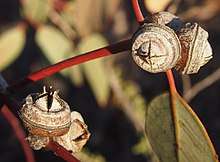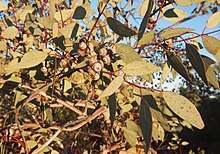Eucalyptus sessilis
| Finke River mallee | |
|---|---|
 | |
| Eucalyptus sessilis habit | |
| Scientific classification | |
| Kingdom: | Plantae |
| Clade: | Angiosperms |
| Clade: | Eudicots |
| Clade: | Rosids |
| Order: | Myrtales |
| Family: | Myrtaceae |
| Genus: | Eucalyptus |
| Species: | E. sessilis |
| Binomial name | |
| Eucalyptus sessilis | |
| Synonyms | |
|
Eucalyptus pachyphylla var. sessilis | |


Eucalyptus sessilis, commonly known as Finke River mallee or river mallee, is a mallee tree that is native to the Northern Territory and central areas along the border of Western Australia.[1]
Description
The tree has a spreading and straggly habit, is typically 2 to 4 metres (7 to 13 ft) in height, and occurs on stony slopes. Its bark is smooth and peels away in strips when shed. The flowering period is between April to July, the stamens that appear from the capsule are a yellow-cream colour.[1] The tree has a spreading straggly habit and the bark is grey in colour. The tree forms a lignotuber from which new stems can form. The alternately arranged adult leaves are dull and green to grey-green in colour.[2] They are supported on petioles that are 1.7 to 4.2 centimetres (0.7 to 1.7 in) in length. The leaf blade is a lanceolate to ovate or elliptical in shape and 6 to 15 centimetres (2.4 to 5.9 in) in length and 1.7 to 6.2 cm (0.7 to 2.4 in) wide with the base rounded to tapering and a pointed apex. Each axillary inflorescence is held erect on stout peduncles. the buds are held in groups of seven and are sessile or with 0.4 cm (0.16 in) pedicels. Mature buds are claret-coloured and have an ovoid to globular shape with a length of 1.8 to 2.5 cm (0.71 to 0.98 in) and a width of 1 to 1.6 cm (0.4 to 0.6 in) with longitudinal ribs.[3] The sessile fruits have a hemispherical shape and are 0.6 to 1.3 cm (0.24 to 0.51 in) long and a width of 1.4 to 2.3 cm (0.55 to 0.91 in). Each fruit is slightly ribbed with a raised disc and four exserted valves. The seeds inside the fruit are grey-brown to blackish 2 to 4 mm (0.08 to 0.16 in) in length with flattened-pyramidal to cuboid shape.[3]
It is both drought and frost resistant, attracts birds and grows well in full sun or part shade.[4][2]
Taxonomy
The species was first described in 1920 by the botanist Joseph Maiden as Eucalyptus pachyphylla var. sessilis in the work A Critical Revision of the Genus Eucalyptus. It was later reclassified by William Blakely to the current name in 1934 as published in A Key to the Eucalypts.[5] A common name for this tree is the Finke River (or River) mallee.[1][6]
The type specimen was collected by Ernest Giles in 1872 at Glen of Palms in the western Macdonnell Range, to the south of Hermannsburg.[7]
Distribution
The tree is found in the central Northern Territory in an area centred around Alice Springs with a scattered distribution that extends west over the Western Australian border into the Goldfields-Esperance region. It is most often found on rocky ranges particularly the MacDonnell Ranges and Central Ranges in the Northern Territory and the Rawlinson Ranges and Walter James Range in Western Australia. It is also scattered through the Finke River basin, Great Sandy Desert and Burt Plains.[3]
See also
References
- 1 2 3 "Eucalyptus sessilis". FloraBase. Western Australian Government Department of Parks and Wildlife.
- 1 2 "Eucalyptus sessilis". Alice Springs Town Council. Retrieved 2 November 2017.
- 1 2 3 "Eucalyptus sessilis (Maiden) Blakely". NT Flora. Northern Territory Government. Retrieved 2 November 2017.
- ↑ "Eucalyptus sessilis". Australian Seed. Retrieved 2 November 2017.
- ↑ "Eucalyptus sessilis (Maiden) Blakely". Atlas of Living Australia. Global Biodiversity Information Facility. Retrieved 2 November 2017.
- ↑ John Turner; Ian Brooker (1978). Finke River mallee: Eucalyptus sessilis (Maiden) Blakely. CSIRO.
- ↑ "Eucalyptus sessilis". Eucalink. Royal Botanic Garden, Sydney. Retrieved 2 November 2017.